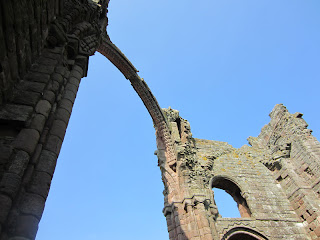 |
| This is how Alanna wades in the ocean! that is Banburgh Castle over her shoulder. |
We had a wonderful trip to Lindisfarne, and saw the Priory, the Castle, and had a lovely walk around the village and the island. Next we went to Banburgh Castle, which is still a private estate. It was a wonderful day with lovely weather, so we enjoyed a wade in the wide sandy beach near the castle.
Lindisfarne is only accessible by a road that is underwater at high tide, so we
had had to change our itinerary a bit to accommodate nature. Apparently,
plenty of tourists don't believe that the tide can come in quickly, and there
were warning signs with graphic pictures of cars under water and people
being. We were up and enjoying breakfast with our fellow guests in the
B&B at 8:00, and were over the causeway to the Holy
Island by 9:20.
We had to wait for the Priory to open, so we walked around the churchyard of St. Mary's and found Nan's counsin's grave right away. We decided to wander down to the beach, looking back toward Beal, and went across the narrow passage to St. Cuthbert's island, where the remains of St. Cuthbert's retreat can be found. It was a beautiful calm morning, with the sea like glass.
 |
| St. Cuthbert's, looking back at St. Mary's and the Priory |
 |
| St. Aiden |
We visited the National Trust Museum, where we learned about St. Aiden, and the history of the Priory. The centre also has a very good explanation of Anglo Saxon art, especially the "Celtic Knot" art. This is really Anglo-Saxon, and I was amazed that it appears not only in stonework, such as grave markers and market crosses, but in gold filigree jewelry, other metal work, texttiles, and most beautifully, on the LIndisfarne Gospels.
Although most of Lindisfarne is a wreck -- the dissolution of the monasteries happened just in time for them to use the stones in the building of the castle -- one can still see the beauty of the warm red stone used in construction, and one last arch is still stretching across the nave.
Lindisfarne has strong connections to Melrose Abbey. St. Aiden entered monastic life at Melrose. St. Cuthbert is an important saint in many ways. When they went to "elevate" his bones nine years after his death for placement in reliquaries, his body was uncorrupted. Therefore, Lindisfarne was an important pilgrimage site until St. Cuthbert's remains were moved to Durham Cathedral for safe keeping, and never returned. The site remains an important place for Christians, however, and both the RC (St. Aiden's) and the Cof E (St. Mary) Churches have services every day. Since Ian and I were here in 1990, two more statues have been added to the collection.
Lindisfarne was attacked by Viking raiders in about 726, and never really recovered. The monastery was fortified, but maintaining an armed force in the priory interfered with the retired religious life. Eventually there were only a few monks left, and much of the monstery was used as a warehouse for the crown. After the dissolution, the lead was stripped from the roof, and the tumbling stones were used to build the castle.
Alanna and I bought postcards, and the clerk suggested that we mail them from the island to get the Lindisfarne postmark. Alanna sent herself a postcard, and I toured the Gospels Garden, which was a beautiful place. I intend to steal their idea for a water feature for our garden back home. I doubt any local towns will let me use their market cross, however.
We toured the local history museum, which strongly concentrates on the Viking raids and the Lindisfarne gospels. There are two amazing quilts in the museum that were inspired by the illuminated gospels. I know my pictures cannot do them justice.
|
|
|
The castle was actually a military post until the end of the nineteenth century, when it was sold to a gentleman who used it as a vacation house, lovingly restored by a very good architect. Much of the furniture was made for the room that it occupies, and the rest is an amazing collection of antiques. Each room was lovely, and the views from the lookouts were spectacular.
We dodged a few sheep and viewed the walled garden that was created by Gertrude Jekyll, the headed back toward the car, ice cream and Flakes in hand.
 |
| Alanna put me in the stocks for "singing ballads" -- one of the crimes. A nice Geordie Lady put her in the stocks. We weren't allowed to smile. |
Banburgh was different from most of the castles that we've seen in that it was not only a Royal Residence (for the kings of Northumbria) but it is still owned and used by the Armstrong Family. The site has been in use for thousands of years, and there is active archeology at and even under the castle, so it is both historically important and very personal. It also has some amazing treasures, including "original" portraits of Kings of England (not the first painting, but official copies made at the time); china, and furnishings. There was the usual stupid torture chamber, but we were able to forgive that, given the excellent archeological section.
After a couple of hours (and a cream tea) we decided to go down through the dunes to the wonderful beach.
 |
| Alanna's attempt to lift mail shirt. |
 |
| Me holding the mail shirt. |
We drove the two hours to our hotel in Carlisle passing Hadrian’s wall, which we had meant to see. We are going to make do with a Roman fort in the Lake District! Such a sacrifice!




















No comments:
Post a Comment